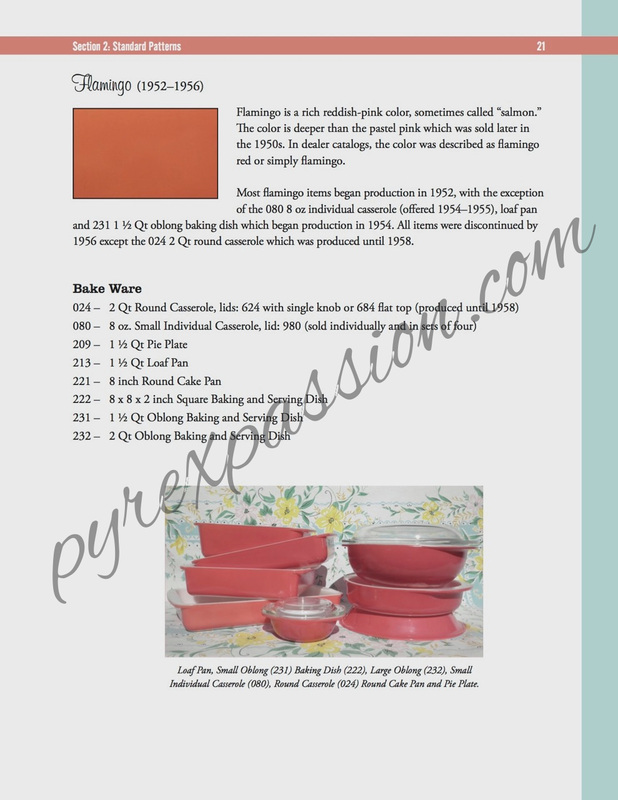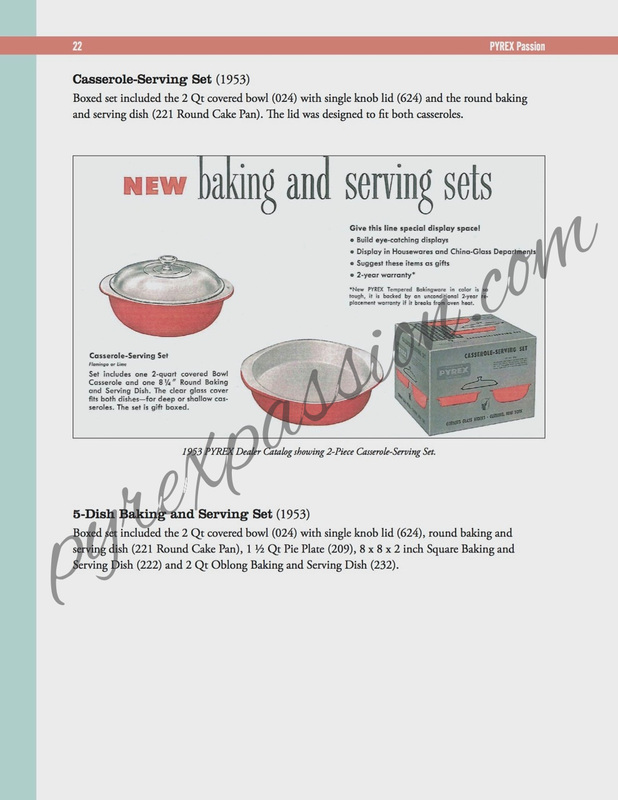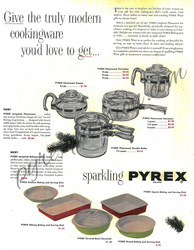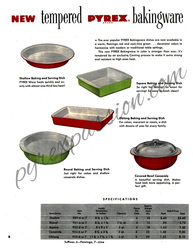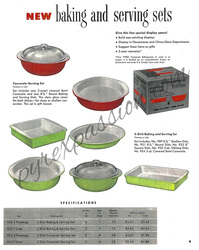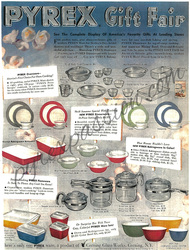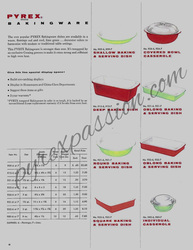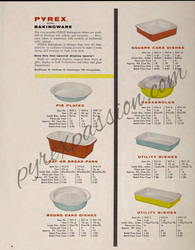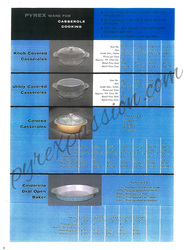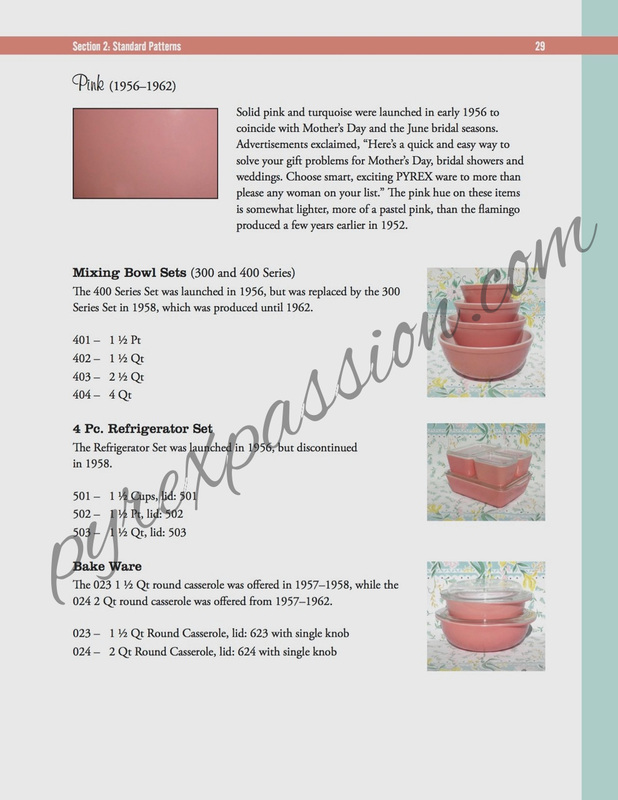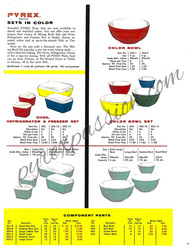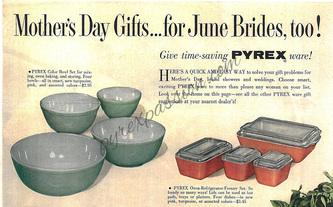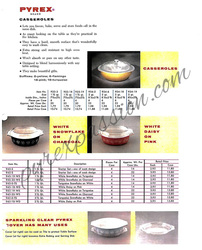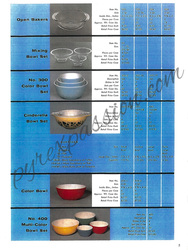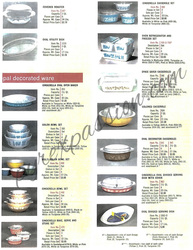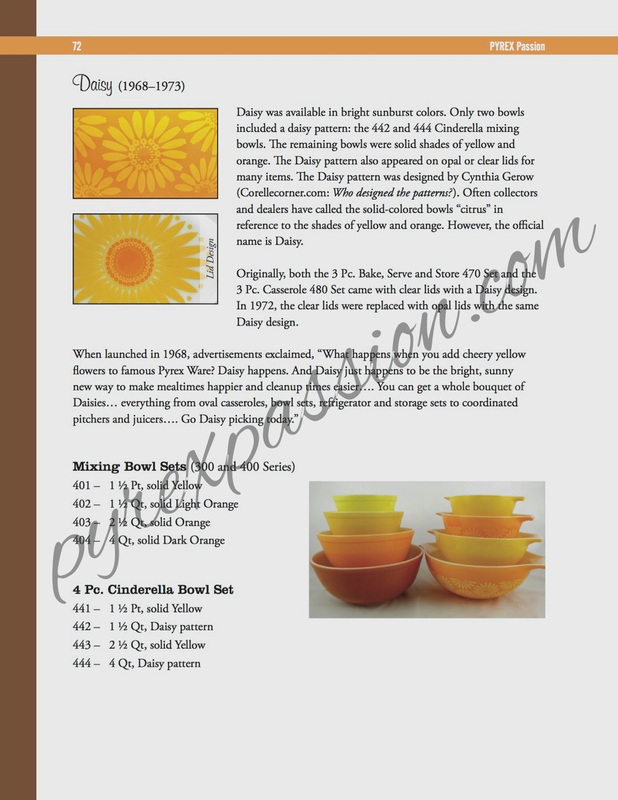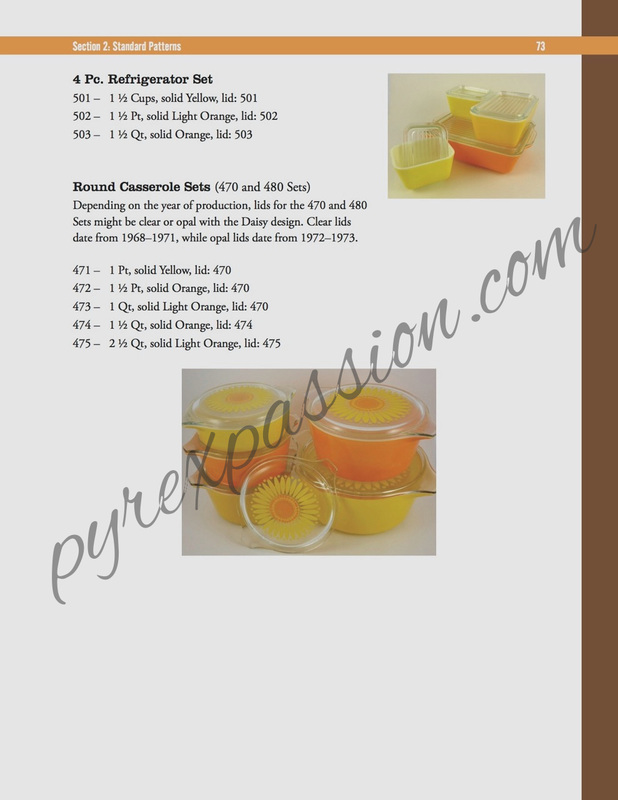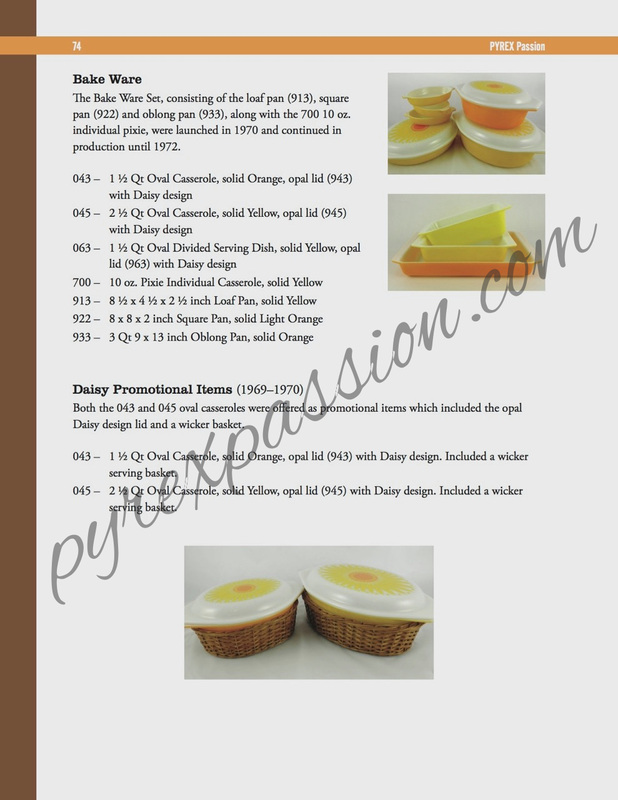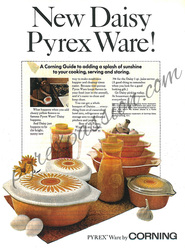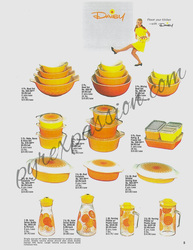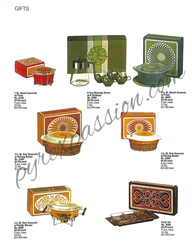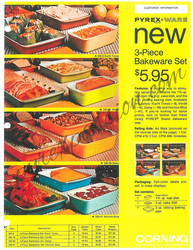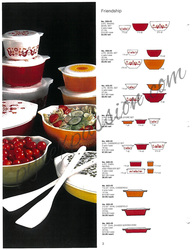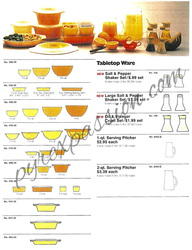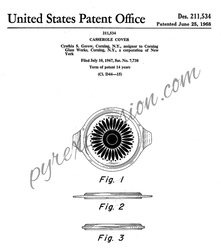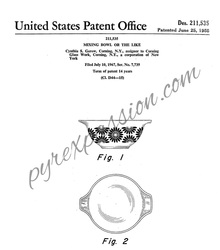Research & Source Information
With the assistance of the helpful research staff at the Rakow Research Library, Corning Museum of Glass, Corning Archives, and the Museum of American Glass in WV, I was able to compile over 10,000 pages of reference documents related to opal Pyrex, such as Corning dealer catalogs, advertisements, marketing kits, dealer promotional ads, trade journal articles, and employee newsletter announcements. Supplementing the library’s materials is my own collection of retailer and stamp redemption program catalogs and thousands of reference images of items and boxed sets. Unless otherwise cited, this documentation is the basis for items described in Pyrex Passion and Pyrex Passion II.
While putting together Pyrex Passion in 2011-2012, my goal was to research all available documentation, present the information in an easy-to-use format, provide photos of each item, and appropriately cite all sources. I received written permission to use photos I hadn’t taken myself. I also met with the rights and reproduction manager at the Corning Museum Rakow Research Library to ensure I could include both the data and images from Corning dealer catalogs, advertisements, and other ephemera. I certainly wanted to give credit where credit was due. It would serve no purpose to do otherwise.
On March 23, 2013, more than a month before Pyrex Passion was published, a website author posted a scathing article claiming that a Pyrex reference book had plagiarized her work. The article insinuated that the book was to a great extent copied from her website and explained in great depth how she had been taken advantage of by this “unscrupulous” person.
My initial reaction to this post was likely the same as most readers. I was appalled that someone did this to her. I did not think for a second that her post was related to Pyrex Passion for many reasons:
Most importantly, I didn’t think the post was about Pyrex Passion because the book had not yet been published. No one had seen it. I couldn’t imagine that the website author would make such allegations about a book she had never actually seen. However, as the weeks went by, I realized that was exactly the case.
On March 23, 2013, more than a month before Pyrex Passion was published, a website author posted a scathing article claiming that a Pyrex reference book had plagiarized her work. The article insinuated that the book was to a great extent copied from her website and explained in great depth how she had been taken advantage of by this “unscrupulous” person.
My initial reaction to this post was likely the same as most readers. I was appalled that someone did this to her. I did not think for a second that her post was related to Pyrex Passion for many reasons:
- I thoroughly researched all the information presented using documentation directly from Corning,
- Pyrex Passion included 100s of items that were not listed on this author’s website at the time,
- I referenced and included images from dozens of trade journals, advertisements, and catalogs that were not previously published in any collector’s guide or on any website, and
- I cited all secondary sources, including the author’s website.
Most importantly, I didn’t think the post was about Pyrex Passion because the book had not yet been published. No one had seen it. I couldn’t imagine that the website author would make such allegations about a book she had never actually seen. However, as the weeks went by, I realized that was exactly the case.
Research Process
Unless otherwise cited, the facts presented in Pyrex Passion represent independent research based on source documentation, such as Corning dealer catalogs, advertisements, and trade journals. The story for each pattern is revealed by comparing multiple source documents and describing the evolution of the pattern throughout its years of production as shown in the examples below. It is certainly not plagiarism to document the facts related to each pattern with documentation to substantiate the information. In fact, most data can be easily obtained by flipping the bowl over and looking at the backstamp. I stand by the integrity of my work and reject the website author's false allegations.
Flamingo |
The evolution of the Flamingo product line is revealed through multiple source documents from 1952 through 1958.
|
Source DocumentsThe following source documents show the key milestones in the pattern's history.
|
As the publication date of Pyrex Passion approached, I scanned every page of the book to figure out how I had offended the website author so severely that she would publish such a personal attack related to a book she had never seen. After a few reviews of the book, I found the error. In the model number section of the guide, I did not appropriately cite text from her website for two items (484 and 485 Sets). All other citations related to this website were correct. I specifically wanted to cite this author’s website because it was well-researched and contained complementary and supplemental information. It seems ridiculous to me that the website author would assume that I would plagiarize information from her site and then link readers to it. That doesn’t make sense.
Unknowingly, I used this page of the book on the Pyrex Passion website as a preview page in anticipation of the book’s release. That’s presumably where the author of the website saw the descriptions for these two items and was offended. Quite frankly, I don’t blame her. However, I would have certainly handled my frustration differently. I would not have insinuated that an entire book was copied word for word, ignoring all evidence to the contrary.
When Pyrex Passion was released on May 1, 2013, this author’s website looked very different than the site looked in 2015. Although the site listed most items available in standard Pyrex patterns, only a few dozen of the 100s of promotional items were mentioned as “Extra Photos.” In 2015, the website author revamped her site, adding many of the promotional items that I had documented in Pyrex Passion. However, I’m not so bold to assume that the website author had plagiarized items from Pyrex Passion. At least in my case, I realize that any researcher can obtain source materials and document items. No one has an exclusive right to publish information that any researcher can obtain through original source documents.
Unknowingly, I used this page of the book on the Pyrex Passion website as a preview page in anticipation of the book’s release. That’s presumably where the author of the website saw the descriptions for these two items and was offended. Quite frankly, I don’t blame her. However, I would have certainly handled my frustration differently. I would not have insinuated that an entire book was copied word for word, ignoring all evidence to the contrary.
When Pyrex Passion was released on May 1, 2013, this author’s website looked very different than the site looked in 2015. Although the site listed most items available in standard Pyrex patterns, only a few dozen of the 100s of promotional items were mentioned as “Extra Photos.” In 2015, the website author revamped her site, adding many of the promotional items that I had documented in Pyrex Passion. However, I’m not so bold to assume that the website author had plagiarized items from Pyrex Passion. At least in my case, I realize that any researcher can obtain source materials and document items. No one has an exclusive right to publish information that any researcher can obtain through original source documents.
Pink |
The evolution of the Pink product line is revealed through multiple source documents from 1956 through 1962.
|
Source DocumentsThe following source documents show the key milestones in the pattern's history.
|
The owner of the website has never contacted me about the error in the book, and contrary to what she stated on her site, I did send her a sincere apology for the citation error mentioned above. Since I caught the error before the release of the book, every copy of the first printing included an addendum correcting the error and citing the text as a direct quotation. In subsequent printings, the error was corrected.
I can understand being frustrated with my error, but I do not believe this warrants writing a personal attack or attempting to convince readers that 200+ pages of content were “plagiarized.” It’s beyond my comprehension why someone would react to an error in such a manner. I made an error, corrected it, and apologized for it to the person I offended. I do not believe it warrants an ongoing personal vendetta toward me. The best course of action would have been to contact me directly to resolve the situation.
Flipping a bowl over and documenting its model number, capacity, and back stamp information is not plagiarism. Looking at a bowl and describing its pattern or reiterating how a pattern was described in advertisements does not constitute plagiarism. In describing Gooseberry Cinderella bowls, the words “pink,” “white,” “alternating,” and “gooseberry” will likely be used. This does not amount to stealing another person’s words. It is a description of the item. Using Pyrex dealer catalogs and advertisements to report set numbers, dates of production, official pattern names, and unique aspects of certain items is documentation, not plagiarism.
I can understand being frustrated with my error, but I do not believe this warrants writing a personal attack or attempting to convince readers that 200+ pages of content were “plagiarized.” It’s beyond my comprehension why someone would react to an error in such a manner. I made an error, corrected it, and apologized for it to the person I offended. I do not believe it warrants an ongoing personal vendetta toward me. The best course of action would have been to contact me directly to resolve the situation.
Flipping a bowl over and documenting its model number, capacity, and back stamp information is not plagiarism. Looking at a bowl and describing its pattern or reiterating how a pattern was described in advertisements does not constitute plagiarism. In describing Gooseberry Cinderella bowls, the words “pink,” “white,” “alternating,” and “gooseberry” will likely be used. This does not amount to stealing another person’s words. It is a description of the item. Using Pyrex dealer catalogs and advertisements to report set numbers, dates of production, official pattern names, and unique aspects of certain items is documentation, not plagiarism.
Daisy |
The evolution of the Daisy product line is revealed through multiple source documents from 1968 through 1973.
|
Source DocumentsThe following source documents show the key milestones in the pattern's history.
|
The website author making false allegations finally resorted to soliciting “testimonials” from readers. She asked them to state that it was unnecessary to spend money on a book when her site fulfilled their needs; acknowledge that she had been taken advantage of; and say that they saw plagiarism in the Pyrex Passion books. In fact, she claimed that “the future of her website” depended on it. On December 7, 2015, the website author removed public access to her site. I certainly didn’t request the removal of her site. I can’t imagine what would motivate this behavior, particularly since the website author does not apparently believe that she is plagiarizing by documenting content from the same Corning source materials.
© 2025 Alvaro Publishing. All rights reserved.
Pyrex, Corelle, Corningware and all other trademarks referenced on this site are registered trademarks of their owners. This site is for reference only and is not affiliated with Corning Incorporated or World Kitchen, LLC.
Pyrex, Corelle, Corningware and all other trademarks referenced on this site are registered trademarks of their owners. This site is for reference only and is not affiliated with Corning Incorporated or World Kitchen, LLC.
